External links
- The original Latin chapter headings of De instructione principis (from the Latin Vicipaedia)
- London, British Library, Cotton MS Julius B XIII, ff 48–173: sole surviving manuscript of the work
De principis instructione (Instruction for a Ruler) is a Latin work by Gerald of Wales. It is divided into three "Distinctions". The first contains moral precepts and reflections; the second and third deal with the history of the later 12th century, with a focus on the character and acts of king Henry II of England and especially his disputes with the kings of France, Louis VII and Philip II and with his own four sons, Henry the Young King, Geoffrey, Duke of Brittany, Richard, count of Poitou and John Lackland.
Gerald was learned in classical, Biblical and medieval Latin literature and in this work cites the Bible, Servius (the commentator on Virgil), Gildas, the Itinerarium Regis Ricardi and many other works.
The Capetian dynasty, also known as the "House of France", is a dynasty of European origin, and a branch of the Robertians and the Karlings. It is among the largest and oldest royal houses in Europe and the world, and consists of Hugh Capet, the founder of the dynasty, and his male-line descendants, who ruled in France without interruption from 987 to 1792, and again from 1814 to 1848. The senior line ruled in France as the House of Capet from the election of Hugh Capet in 987 until the death of Charles IV in 1328. That line was succeeded by cadet branches, the Houses of Valois and then Bourbon, which ruled without interruption until the French Revolution abolished the monarchy in 1792. The Bourbons were restored in 1814 in the aftermath of Napoleon's defeat, but had to vacate the throne again in 1830 in favor of the last Capetian monarch of France, Louis Philippe I, who belonged to the House of Orléans. Cadet branches of the Capetian House of Bourbon are still reigning over Spain and Luxembourg.

Philip II, byname Philip Augustus, was King of France from 1180 to 1223. His predecessors had been known as kings of the Franks, but from 1190 onward, Philip became the first French monarch to style himself "King of France". The son of King Louis VII and his third wife, Adela of Champagne, he was originally nicknamed Dieudonné (God-given) because he was a first son and born late in his father's life. Philip was given the epithet "Augustus" by the chronicler Rigord for having extended the crown lands of France so remarkably.

Richard I, known as Richard Cœur de Lion or Richard the Lionheart because of his reputation as a great military leader and warrior, was King of England from 1189 until his death in 1199. He also ruled as Duke of Normandy, Aquitaine, and Gascony; Lord of Cyprus; Count of Poitiers, Anjou, Maine, and Nantes; and was overlord of Brittany at various times during the same period. He was the third of five sons of Henry II of England and Eleanor of Aquitaine and was therefore not expected to become king, but his two elder brothers predeceased their father.
The 1170s was a decade of the Julian Calendar which began on January 1, 1170, and ended on December 31, 1179.
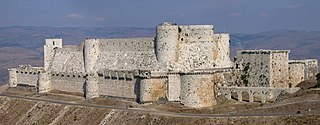
Year 1188 (MCLXXXVIII) was a leap year starting on Friday of the Julian calendar.
The 1180s was a decade of the Julian Calendar which began on January 1, 1180, and ended on December 31, 1189.
The 1190s was a decade of the Julian Calendar which began on January 1, 1190, and ended on December 31, 1199.
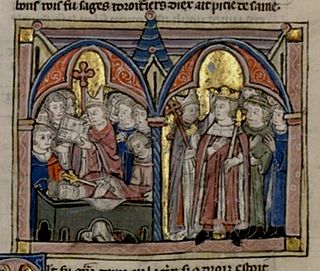
Year 1174 (MCLXXIV) was a common year starting on Tuesday of the Julian calendar, the 1174th year of the Common Era (CE) and Anno Domini (AD) designations, the 174th year of the 2nd millennium, the 74th year of the 12th century, and the 5th year of the 1170s decade.

Louis VII, called the Younger, or the Young, was King of France from 1137 to 1180. He was the son and successor of King Louis VI and married Duchess Eleanor of Aquitaine, one of the wealthiest and most powerful women in western Europe. The marriage temporarily extended the Capetian lands to the Pyrenees.
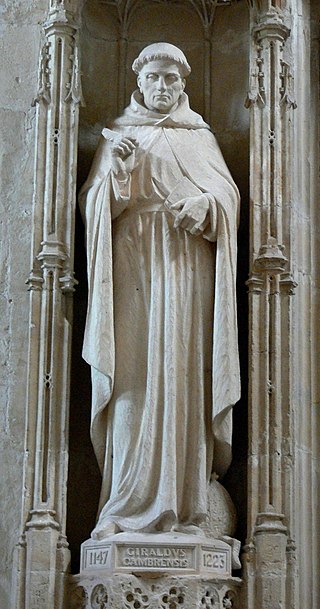
Gerald of Wales was a Cambro-Norman priest and historian. As a royal clerk to the king and two archbishops, he travelled widely and wrote extensively. He studied and taught in France and visited Rome several times, meeting the Pope. He was nominated for several bishoprics but turned them down in the hope of becoming Bishop of St Davids, but was unsuccessful despite considerable support. His final post was as Archdeacon of Brecon, from which he retired to academic study for the remainder of his life. Much of his writing survives.

The Capetian house of Valois was a cadet branch of the Capetian dynasty. They succeeded the House of Capet to the French throne, and were the royal house of France from 1328 to 1589. Junior members of the family founded cadet branches in Orléans, Anjou, Burgundy, and Alençon.

The Third Crusade (1189–1192) was an attempt led by three European monarchs of Western Christianity to reconquer the Holy Land following the capture of Jerusalem by the Ayyubid sultan Saladin in 1187. For this reason, the Third Crusade is also known as the Kings' Crusade.

Geoffrey II was Duke of Brittany and 3rd Earl of Richmond between 1181 and 1186, through his marriage to Constance, Duchess of Brittany. Geoffrey was the fourth of five sons of Henry II of England and Eleanor, Duchess of Aquitaine.
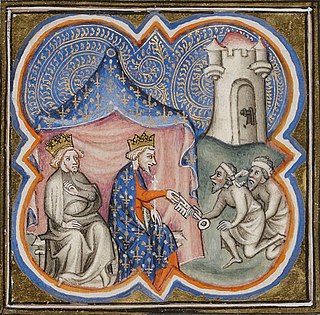
The siege of Acre was the first significant counterattack by Guy of Jerusalem against Saladin, leader of the Muslims in Syria and Egypt. This pivotal siege formed part of what later became known as the Third Crusade. The siege lasted from August 1189 until July 1191, in which time the city's coastal position meant the attacking Latin force were unable to fully invest the city and Saladin was unable to fully relieve it with both sides receiving supplies and resources by sea. Finally, it was a key victory for the Crusaders and a serious setback for Saladin's ambition to destroy the Crusader states.
Heraclius or Eraclius, was archbishop of Caesarea and Latin Patriarch of Jerusalem.
The Saladin tithe, or the Aid of 1188, was a tax levied in England and, to some extent, France, in 1188, in response to the capture of Jerusalem by Saladin in 1187.
Alys of France, Countess of Vexin, known in English as "Alice", was a French princess, initially betrothed to Richard of England. Her engagement was broken in 1190, through negotiations between Richard and her half-brother Philip Augustus of France. Philip then attempted to betroth her to King John of England but it was rejected. Alys married William IV, Count of Ponthieu on 20 August 1195. She died between 1218 and 1220.
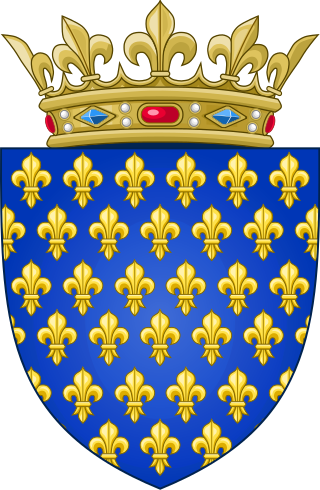
The House of Capet ruled the Kingdom of France from 987 to 1328. It was the most senior line of the Capetian dynasty – itself a derivative dynasty from the Robertians.
Joscius was Archbishop of Tyre in the crusader Kingdom of Jerusalem in the late 12th century.
Events from the 1180s in England.